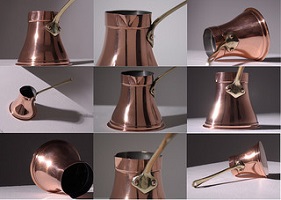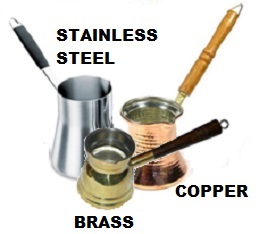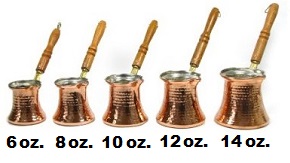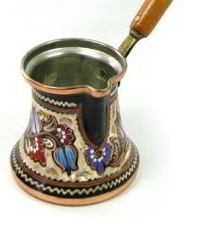Turkish Coffee Pot – All you Need to Know About it
The Turkish coffee pot (“cezve”) is the first utensil that you must own to make proper Turkish style coffee. It’s the most distinguished item of the whole procedure.
 The Turkish coffee pot is a unique utensil that we use to make Turkish coffee. It is the most important and irreplaceable part of this coffee making method.
The Turkish coffee pot is a unique utensil that we use to make Turkish coffee. It is the most important and irreplaceable part of this coffee making method.
It’s a small metallic pot with a wide base and a narrow top. There is a spout on its left side for pouring the coffee without spilling, using your right hand. Unfortunately, in order to find one for “leftists” (spout at right) it is extremely difficult.
Preferable metals for its construction are copper (traditional), brass, aluminum and stainless steel. Its shape (wide bottom-narrow rim) is the trick to create rich foam without boiling the content of the pot.
Turkey is the larger supplier of copper and brass pots in the world. Its experienced craftsmen (Anatolia’s artisans are very famous) form and hand-hammer most of the production. Artists also engrave them or paint them with traditional motifs and decorate them with colorful glazes.
There are a lot of different names for Turkish coffee pot. The most common worldwide though are the Turkish /Arabic “cezve” or “ibrik” and the Greek “briki“.
If you are interested in learning more names Wikipedia has a special section just for them.
Turkish Coffee Pot – How to Use it
Learning how to properly use a Turkish coffee pot seems simple at first glance.
It all depends how you proceed with the making procedure. You must follow a certain recipe that fits your taste. (In my website you can find such recipes (Turkish, Greek and Israeli) with clear instructions).
That’s where you will come in contact with the real usage of the Turkish coffee pot. The details involved though will make the difference.
Small saucepans that some “experts” suggest using are completely inappropriate. Foam plays a significant role in achieving the best tasting Turkish coffee. Saucepans cannot create and hold the right foam.
A modern approach to mass production of Turkish coffee calls for the usage of special automatic machines or electric pots. If you are not an expert user of them the result would be a mediocre coffee.
There is no comparison in taste when you make coffee in a traditional Turkish coffee pot.
Turkish Coffee Pot Made Materials
 The most favorable materials of the manufacturers of Turkish coffee pots are copper, brass and stainless steel. Turkish households also use enamel coffee pots.
The most favorable materials of the manufacturers of Turkish coffee pots are copper, brass and stainless steel. Turkish households also use enamel coffee pots.
Tin is another metal that makers use but mostly to line internally copper and brass coffee pots. It’s the silver color material you see inside the pots. The tin pot lining prevents the water-copper contact which creates oxidation. It also provides durability and easy clean-up.
Copper coffee pot is the number one in sales. It’s a souvenir item all over Turkey. It is a reminder of traditions but also an unbeatable means of uniform brewing of Turkish coffee.
Nowadays, brass pot is not in great demand. Since copper heats faster than brass manufacturers prefer to use it in making the handles of the coffee pot. Brass reduces heat conductance which eventually protects your hands while holding the coffee pot on the heat source.
Stainless steel Turkish coffee pot is the new generation’s favorable Turkish coffee utensil. It has brilliant luster, it’s rust-resistant and easy to clean and take care of. It produces inferior foam but experienced user can overcome this obstacle by using very low heat.
Importance of Handle in Turkish Coffee Pot
You hold the pot from a long handle (solid wood or brass). The handle is necessary and particularly useful. It protects your hand from burning (you place the pot directly on a heating source). The stainless steel Turkish coffee pots have handles with heat resistant phenol plastic.
Turkish coffee pots carry diverse handles depending on their material type.
(Before buying, check if the pot’s handle is resistant to heat).
For ergonomic reasons, proper length and angle are two other important elements you might pay attention to.
Turkish Coffee Pot Sizes
 The size of a Turkish coffee pot is another important element of this coffee type that requires attention. Wrong size equals possibility of foam-less coffee.
The size of a Turkish coffee pot is another important element of this coffee type that requires attention. Wrong size equals possibility of foam-less coffee.
Is “one size fits all” scheme suitable in Turkish coffee pots? Unfortunately, the answer is NO. You should neither use a too small nor a too big Turkish pot. Depending upon the quantities of coffees, you need to choose the appropriate size of pot as well.
The water level should come up a little higher than the middle line of the pot (for amateur makers); or 1 inch below its rim (for expert makers). The reason is simple. Turkish coffee needs room for its foam to rise.
Selecting the Proper Size
Turkish coffee pot manufacturers give information about the product that might not be clear for the average coffee drinker. Most of the times you will see the following measurements:
(a) Demitasse cups (good practice)
(b) Descriptive words like Small, Medium, Large, etc. (worst practice)
(c) Volume capacity (best practice)
When the seller’s description is in “cups” you must understand that these cups hold 2 oz / ~60 ml of coffee. The trick here is NOT to order an exact size. You need the room of another cup for the foam to rise. So if you would make 2 cups of Turkish coffee then you need a pot that actually holds 3 cups.
The question here is whether or not the seller has included this crucial detail in the description. My research found that some of them do. But, I have seen and a 4 oz. pot claiming that it can make 2 cups of Turkish coffee. NO, it can make 1 cup of Turkish coffee.
A very misleading approach is to buy a Turkish coffee pot by just reading size in words: S-M-L-XL.
Most of the complaints that people publish in online stores have to do with the wrong size of the pot. Not to mention that they think that a medium pot stating 3 cups will hold 3… mugs of liquid!
Turkish coffee pots with volume capacity description are the most helpful. Don’t forget to subtract at least 2 oz. before dividing the number. For example a pot stating 10 oz. capacity means: (10 – 2) / 2 = 4. Usually this size of pot is suitable for 3-4 cups of Turkish coffee.
Traditionally, Turkish households have a full set of pots. They help them match any amount of coffee with the best results.
Copper Turkish coffee pot (“cezve” / “ibrik”)
Copper Turkish coffee pot is the ultimate choice of the professionals and followers of culture. It’s one of the distinctive images of Turkish coffee.
 Copper as a metal has the ability to diffuse heat evenly and conduct it fast. For this property it gained tremendous popularity in the cookware industry worldwide. Copper coffee pots heat water quickly in low heat. That means excellent balanced foam which is the most needed value of Turkish coffee.
Copper as a metal has the ability to diffuse heat evenly and conduct it fast. For this property it gained tremendous popularity in the cookware industry worldwide. Copper coffee pots heat water quickly in low heat. That means excellent balanced foam which is the most needed value of Turkish coffee.
It is mostly hand-made in Turkey by skillful craftsmen. You can also find it though as a mass production item by other countries as well.
The traditional Turkish copper pot carries decorative outside patterns (stamped or hand painted). Also, engravings with chisel which make the pot a piece of art.
The interior of a copper Turkish coffee pot has a thin layer of tin.
After certain years of use though, it will need another layer. Tin specialists can do the job to ensure the safety of the pot and your health.
Before proceeding though with re-tinning you should check prices since they tend to be very expensive.
I suggest buying a new one unless you find a tinsmith company around your area. The cost of shipping and re-tinning a coffee pot will surprise you…
Watch the following educational video to learn how Turkish coffee pot is made.
High Quality Copper Turkish Coffee Pots
Finding a high quality copper Turkish coffee pot needs some technical knowledge. A few reading observations for online products are also useful.
Below you can find the properties that you should consider before investing in a copper Turkish pot. Some of these criteria will also help you see why there is such a difference in price.
(a) Check the thickness of the copper sheet. Most of the cheap pots are less or equal to 0.5 mm. The quality ones though use 1 mm up to 1.5 mm copper sheets. The pot is obviously thicker (ideal heat conductivity). Of course it lasts longer with minimum problems. Thin copper coffee pots tend to leak after a few months of usage because heat wears down the copper.
(b) Check the handle and the sides of the pot. If the handle is loose then it means leaking trouble.
(c) Check if there are brass connectors holding the handle on the pot’s main. It’s another good sign that your pot will not leak.
For online buyers: Most of the above properties are absent from the descriptions of the products.
Do not buy them just for the sake of the price.
Copper Turkish Pots and Health Issues
 Copper Turkish pots can become a health issue under certain circumstances. This is an issue of copper becoming toxic after consumption of large amounts of it.
Copper Turkish pots can become a health issue under certain circumstances. This is an issue of copper becoming toxic after consumption of large amounts of it.
MedlinePlus (U.S. National Library of Medicine) states the 900 mcg per day (adults) as a proper dietary intake for copper.
The copper issue is mostly related to cookware and acidic foods.
Coffee acidity varies between 4.5 to 5 PH (7 PH = Neutral). Making coffee in a copper pot can become unhealthy only if the inside tin layer wears out. Copper will then dissolve into your coffee (noticeable metallic taste). In excess amounts (not determined yet) it will cause nausea, vomiting and diarrhea.
Copper cookware toxicity is something you should look upon with caution. Check your pots regularly during cleaning for deep scratches. Have in mind that brass coffee pots contain copper as well.
Where to Buy Turkish coffee pot
There are different criteria to consider when choosing to buy the appropriate Turkish coffee pot: materials, handle and size.
If you live in an area where you can find a descent collection of them, then check them out. The quality standards we have talked about are critical. Otherwise go to an online store.
 |
 |
 |
 |
Turkish Coffee Pot Maintenance and Cleaning Tips
Learning how to maintain your Turkish coffee pot is always useful.
Copper pots are the ones that need special attention for long-lasting results.
Copper is sensitive to air and becomes dull by oxidation. You can shine copper pots properly either by using market chemicals (i.e. anti-tarnish cream) or natural products.
Turkish households prefer the second choice. They rub their coffee pots with lemon and salt (cut a lemon in half and sprinkle it with salt).
Cleaning Process and Tips
- The outside of the Turkish coffee pot
You should clean it according to its made material:
- Wash your stainless steel or enamel pots as usual. You don’t have to change your washing habits.
- Copper/tin/brass coffee pots we suggest that you wash them using only warm water and rubbing them gently with a soft sponge.
- The inside of the Turkish coffee pot (usually tin)
- You should wash it only with water. Tin (the inline material) is a soft metal and needs dedicate cleaning to last for a long time.
- Avoid soaps and detergents as much as possible. They negatively affect the aroma of the coffee.
Strong suggestion: Since copper Turkish coffee have tin inside (some of them and outside) please ask the seller if the item is “Lead free”. Tin is expensive so manufacturers tend to mix it with lead, which is a hazard to your health.
Tip #1: When you have finish pouring the coffee into the cups, rinse the coffee pot with water at once. You will prevent grinds from drying into the pot.
Tip #2. Dry your pots completely using a soft kitchen towel. It will prevent the creation of spots onto its outer surface.
Photo credits/attributions:
{1} Turkish Coffee Pot Typlolgy Photo Glassness / CC BY